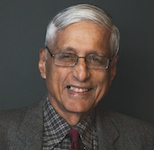The Menacing Lions Don't Do India Proud
The distortion is serious and ought to be undone. Our national emblem is not a toy to which a child can give a new shape. It stands for the meaning of India, and for the message of the Indian state. Our courts display it and thereby promise integrity and impartiality. Through the emblem, our coins and currency notes assure legitimacy.
Suddenly, without notice to anyone, without consultation with parliament, or the states, or public opinion, the emblem is not only modified, but then installed, in all its heavy tonnage, on top of the new parliament building! The calm, confident, reassuring, protecting lions have been replaced by a set of snarling, menacing lions!
It's like removing the flame of freedom from the raised hand of the Statue of Liberty near New York and replacing it with an assault rifle. (Some in the U.S. will no doubt welcome such a change.)
Everything about the event was flawed. The unilateral change in the emblem. Prayers of only one religion consecrating a ceremony of the religiously impartial Indian state. The absence from the event of the President of India, who among other things is our parliament's head. The absence also of the Vice President of India, who chairs the Rajya Sabha, which is an inseparable part of parliament. The absence of leaders of the Opposition. One can easily go on.
But more than the event, it's the fact that from now onward, an altered symbol will speak to the world from a dominating perch above the new parliament building that should profoundly disturb every Indian. The excuses are utterly unconvincing. "Artists should have their freedom." "It's only when seen from below that the lions look enraged." How many will see the lions from above?
Jawhar Sircar of the Trinamool Congress, a Rajya Sabha MP, was surely right when he contrasted "the majestic Ashokan Lions" of our national symbol, which are "graceful" and "regally confident", with the "unnecessarily aggressive" lions now unilaterally installed. Other MPs too have expressed their shock and misgivings, including Jawhar Sircar's party colleague, Mahua Moitra. Leaders from the Congress and the Rashtriya Janata Dal have also expressed their views in plain language, and the Left parties have pointed out, referring to the religious ceremony accompanying the installation, that India belongs to people of different religions and also to those who may not have a religious belief.
But the matter is beyond politics. What is at stake are the bonds that keep India and the Indian people united. And the nation's moral and educational tone is involved. Are we to go forward in trust and friendship - or will we frighten one another into cooperation? Will parents raise children with the image of menacing lions, and will intimidation now be the primary virtue that teachers in India's schools strive to instill in their pupils?
Anyone who thinks that the alteration was merely artistic or unintentional will believe anything. Or justify anything. The change from the lion who protects to the lion who threatens must have been entirely deliberate. And it is possible that before long, the alteration is defended as being intentional, necessary, and appropriate.
Who is the target of the lions' warning? Those who decided on the change will no doubt tell us one day. But another question is perhaps more important: how will India's vulnerable millions, and India's neighbours large and small, interpret the altered emblem? The Indian state possesses nuclear weapons. It has one of the world's largest armies. It has access to, and can purchase, our world's most sophisticated security and defence technologies, including the ones enhanced by artificial intelligence. The Indian state also has a formidable array of forces for internal policing. When such a state modifies its emblem, and places a new and unfriendly emblem on a prestigious new height, what conclusions will people draw? That it is suddenly unsure of itself?
Do we not know, moreover, that already millions of men and women in different parts of our land - including in the country's far north, in the northeast, in the east, in the south - are feeling excluded, neglected, bullied, suppressed, unheard? Will angry lions reassure them? It's not merely India's religious minorities, or those who inhabit border regions, who feel that they cannot count on the justice, the liberty, the equality, the dignity, and the fraternity that the Constitution promises them. Large sections of the majority community, and large portions of the heartland population, including Dalits and Adivasis, also feel unfairly treated, ignored, and unheard.
You cannot frighten people into cooperation or participation. You have to win them with goodwill and respect.
The world needs to be told that goodwill and friendship remain at the core of India's message, and that India's strength is meant to protect itself, not to threaten anyone. Prime Minister Modi will gain, not lose, if his government orders a correction, and majestic, alert, and calm lions return to represent India.
